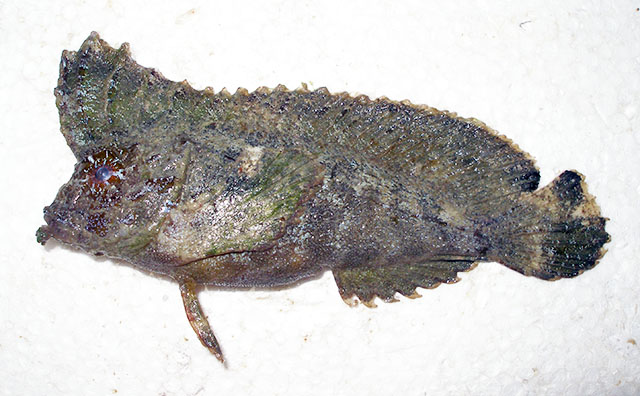| Aploactinidae (Velvetfishes) |
| 9.74 cm SL (male/unsexed) |
|
reef-associated; marine; depth range 0 - 13 m |
| Eastern Indian Ocean: Western Australia. |
|
Dorsal spines (total): 13-14; Dorsal soft rays (total): 13-14; Anal spines: 1-1; Anal soft rays: 9-11; Vertebrae: 31-32. This species is distinguished by the following characters: D XIII-XIV,13i-14i; A I,9i-11i; pectoral-fin rays 11-12; pelvic-fin rays I,3; gill rakers on first gill arch 0-4 + 5-8, 6-11 total; lateral-line tubes 13-17; vertebrae, including urostyle, 31-32; dorsal-, anal-, pectoral-, first two pelvic- and most caudal-fin rays are branched near their tips, except in juveniles; last soft dorsal-fin ray joined for most of its length by a membrane to the proximal third of upper caudal-fin ray; spinous dorsal fin strongly notched, between 3rd and 8th spines; relatively robust pelvic fins, with third or innermost ray subequal to second ray; smooth anterior face of lower lip, a single row of small unbranched cirri along its upper margin; forehead with a narrow quadrangular pit, bounded by frontal, supraorbital, ocular and preocular ridges (Ref. 89851).
Description: Pseudopataecus carnatobarbatus differs from P. taenianotus by its branched (vs. simple) tips to most fin rays, last soft dorsal-fin ray joined by membrane more fully to upper caudal-fin ray, spinous dorsal fin more distinctly notched, pelvic fins more robust, anterior face of lower lip smooth (vs. profusely covered with cirri), and a narrow quadrangular pit on the forehead, bounded by frontal, supraorbital, ocular and preocular ridges (vs. no pit and preocular ridge); modally, has fewer anal-fin rays and greater numbers of gill rakers (Ref. 89851). |
| Collected and observed usually in broad shallow pools within degenerating low-relief reef, with dead coral heads, overhangs and crevices, with scattered shell and coral rubble, often among thick stands of brown macroalgae, Padina and Sargassum species (Ref. 89851). |
|
Not Evaluated (N.E.) Ref. (130435)
|
| harmless |
|
Source and more info: www.fishbase.org. For personal, classroom, and other internal use only. Not for publication.

